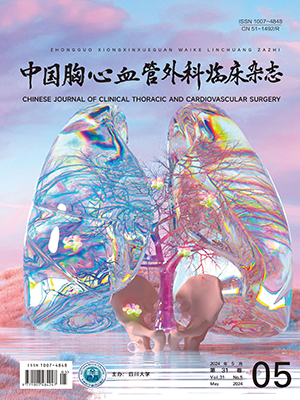Objective To summary the clinical experiences of ventricular septal myotomymyectomy on hypertrophic obstructive cardiomyopathy(HOCM) and investigate the treatment strategies during perioperative period for better clinical results. Methods From October 1996 to June 2009, 62 patients with HOCM underwent surgical treatment. There were 41 male and 21 female, aged 668 years with mean 34.05 years. The ventricular septal myotomymyectomy operation (Morrow operation or modified Morrow operation) was performed through the aortic incision under general anesthesia and hypothermic cardiopulmonary bypass (CPB). The concomitant operations included coronary artery bypass grafting (5 cases), mitral valve replacement (12 cases), mitral valve plasty(9 cases), aortic valve replacement (4 cases), tricuspid valve plasty(2 cases) and ductus arteriosus closure (2 cases). During the perioperative period, the patients were examined by echocardiography or transesophageal echocardiograph(TEE), electrocardiogram or dynamic echocardiogram and chest radiography. Left atrial diameter,left ventricular enddiastolic [CM(159mm]diameter,left ventricular outflow tract (LVOT) pressuregradient,interventricular septal thickness, ejection fraction[CM)](EF), the changes of mitral valve construction and function were evaluated. Results The time of CPB and aortic occlusion were 104.23±47.14 min and 66.76±36.32 min, respectively. The endotracheal intubation time was 13.23±11.76 h and the postoperative intensive care unit(ICU) stay was 42.53±37.41 h. Four patients died and the mortality was 6.45%(4/62). The main causes of death included septic shock complicated with acute renal failure(1 case), refractory arrhythmia, ventricular fibrillation, atrial flutter complicated with severe low cardiac output syndrome (1 case), severe acute renal failure(1 case) and Ⅲ°atrioventricular(AV) block complicated with low cardiac output syndrome(1 case). Postoperative left atrial diameter (34.56±6.45 mm vs.43.46±7.21 mm,t=6.948,P=0.000), left ventricular enddiastolic diameter (37.14±6.31 mm vs.42.03±6.23 mm,t=3.145,P=0.020), LVOT pressure gradient (23.54±17.78 mm Hg vs. 103.84±44.04 mm Hg,t=13.618,P=0.000) and interventricular septal thickness (17.12±5.67 mm vs.26.93±5.23 mm, t=10.694,P=0.000) decreased significantly compared with those before operation. There was no mitral valve regurgitation, or only mild mitral valve regurgitation. No systolic anterior motion(SAM) was found. The main postoperative arrhythmias included complete left bundle branch block, intraventricular block, complete atrioventricular block and atrial fibrillation. All the 58 cases were cured and discharged. Fiftythree cases were followed up for 3 months12 years, and 5 cases were lost. No death, complication and reoperation were found. Symptoms relieved significantly. The cardiac function was in New York Heart Association grade Ⅰ-Ⅱ. The quality of life improved significantly. Conclusion Most patients with HOCM can achieve satisfactory relief of LVOT obstruction and SAM via ventricular septal myotomymyectomy. The main arrhythmias after operation are bundle branch block and atrial fibrillation. Satisfactory effects can be achieved by accurate surgical technique and effective drug treatments.
Citation: CUI Bin,XU Jianping,WANG Wei,et al .. Ventricular Septal Myotomymyectomy on Hypertrophic Obstructive Cardiomyopathy and the Treatment Strategies during Perioperative Period. Chinese Journal of Clinical Thoracic and Cardiovascular Surgery, 2010, 17(1): 6-9. doi: Copy




